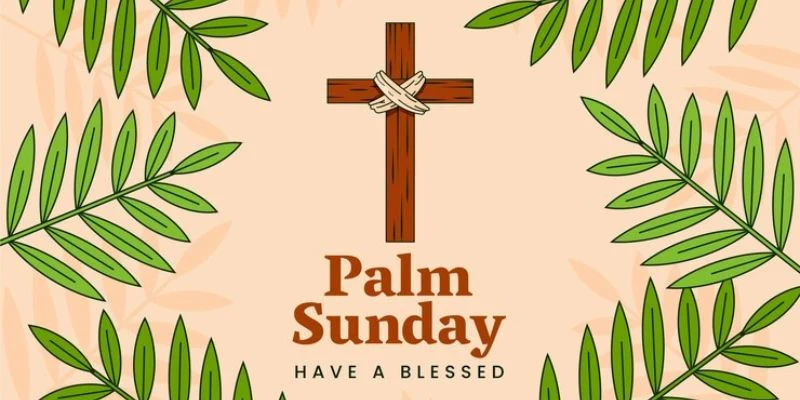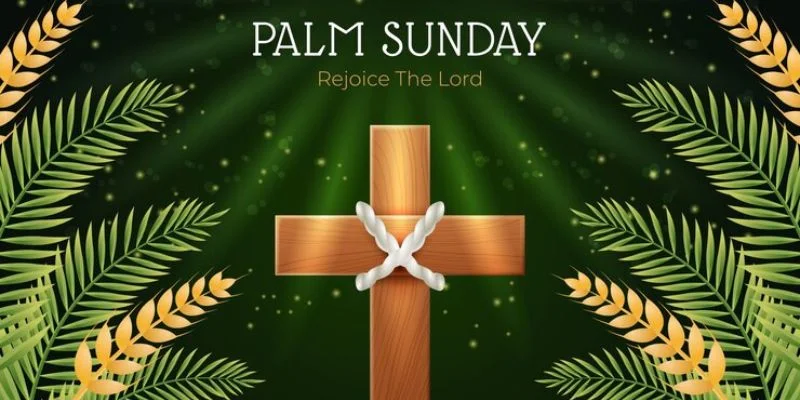How to Celebrate Happy Palm Sunday: Traditions and Activities for All Ages
Updated: April 14, 2024
153
Happy Palm Sunday! Today marks a joyous and significant day in the Christian calendar. It is a day filled with waving palm branches, singing hymns, and commemorating a pivotal moment in the life of Jesus Christ. But what exactly does Palm Sunday represent, and how did this tradition come to be? Let’s delve into the history and symbolism behind this special occasion, exploring its meaning and how it’s celebrated worldwide.
Happy palm Sunday Prayer
| Happy Palm Sunday Prayer for Everyone |
|---|
|
Significance of Palm Sunday in Christianity
Palm Sunday might seem like a day of pure celebration, with parades of people waving palm branches and shouts of joy. But dig a little deeper, and you’ll discover a more complex story that reflects the essence of the Christian faith.

Here’s why Palm Sunday holds such significance:
Triumphant Entry, Humble King
The crowds cheering for Jesus weren’t just welcoming a friend. Palm branches, in those days, symbolized victory and royalty. They were hailing Jesus as their king! It sets the stage for a powerful twist.
A King Who Serves
Jesus entered Jerusalem on a donkey despite the cheers, symbolizing humility. It’s a reminder that Jesus’s kingdom isn’t about worldly power but service and sacrifice.
The Beginning of the End
Palm Sunday marks the start of Holy Week, the week leading up to Jesus’s crucifixion. The joyful celebration is a stark contrast to the suffering that awaits Jesus. It’s a way of saying that even in the face of hardship, we remember the hope Jesus brought.
So, Palm Sunday is a day of mixed emotions. It is a celebration of Jesus’s arrival and his message, but also a sad reminder of the sacrifice he was about to make. It’s a day that reflects the complexities of faith: joy and sorrow, hope and sacrifice, all woven together.
History of Palm Sunday
Palm Sunday flutters into focus each year, a week before Easter. But what exactly does this day commemorate? It is a journey back in time to a pivotal moment in the life of Jesus Christ.
Imagine a bustling Jerusalem packed with people celebrating Passover. Jesus, known for his teachings and miracles, arrives riding a donkey. This was not a random choice – donkeys were associated with peace, unlike the warhorses of conquering rulers.
The crowd erupts! People throw palm branches, a symbol of victory and joy, on the ground before him. They shout “Hosanna!” a Hebrew phrase meaning “Save us!” The atmosphere is electric. They see Jesus as a potential savior, a leader who might bring positive change.
But here’s the twist: Palm Sunday is not just about cheers and celebration. It begins Holy Week, a somber countdown to Jesus’ crucifixion. The joyous shouts foreshadow the dramatic events – the betrayal, the trial, and the sacrifice on the cross.
Importance of Palm Sunday in the Christian calendar
Every year, the Christian calendar ushers in a special Palm Sunday. It’s a day marked by a unique blend of celebration and quiet reflection, kicking off a particularly significant week in the faith – Holy Week. But why exactly is Palm Sunday so important?
Imagine a joyous parade – people lining the streets, waving palm branches, and cheering for a triumphant arrival. This is the scene Palm Sunday commemorates: Jesus’ entry into Jerusalem. Traditionally symbolizing victory and royalty, the palm branches represent the crowd’s enthusiastic welcome for Jesus. It’s a day to remember Jesus’ message of hope and peace.
However, Palm Sunday isn’t just about cheers and celebration. Look a little closer, and you’ll see the bittersweet reality. Jesus rode a donkey, a symbol of humility, into the city. This foreshadows the events that will unfold in the coming days – his betrayal, suffering, and, ultimately, his crucifixion.
So, Palm Sunday bridges the gap between Jesus’ message of hope and the approaching events of Holy Week. It’s a day to acknowledge the joyful reception Jesus received while remembering the sacrifice he was about to make. It’s a time for celebration and quiet contemplation as Christians prepare for the most sacred week in their faith.
Palm Sunday in Jerusalem
- The air crackles with excitement in Jerusalem on Palm Sunday. People line the streets, waving branches of vibrant green palms, creating a sea of happy chaos.
- Chants of “Hosanna!” echo through the ancient city as the crowd welcomes Jesus, a sense of hope and celebration filling the air.
- Dressed in their best clothes, children skip along, waving their little palms with glee, a contagious joy washing over the city.
- The springtime scent mingles with the dust stirred by the crowd, creating a unique Jerusalem fragrance that lingers in the memory.
- Sunlight glints off the golden dome of the Temple Mount, casting a warm glow on the triumphant procession through the heart of the holy city.
The significance of Jerusalem in the story of Palm Sunday
Palm Sunday is the same as Jerusalem. This city, considered holy by the Jews, becomes the dramatic backdrop for Jesus’ grand entrance. Here’s why it matters:
City of Kings
Jerusalem was the historical capital of King David, a revered figure in Jewish tradition. Jesus entering on a donkey, a symbol of peace, could be seen as a humble claim to this lineage.
Center of Faith
The city housed the sacred Temple, a central point of worship. Jesus’ arrival there sent a powerful message, placing him at the heart of Jewish religious life.
A Prophetic Move
The Gospels mention Jesus fulfilling a prophecy by entering Jerusalem this way. This act linked him to past leaders and signaled the unfolding of a grander plan.
The symbolism of Crowds
Jerusalem was a bustling city, and the large crowds welcoming Jesus held a special weight. Their cheers and palm branches displayed a public acceptance of Jesus, which would tragically turn later in the week.

The impact of Palm Sunday celebrations in Jerusalem on Christians worldwide
Every year, the cobbled streets of Jerusalem witness a special kind of magic on Palm Sunday. Thousands of pilgrims and local Christians come together to recreate the triumphant entry of Jesus into the city. But this celebration isn’t just a local spectacle; it sends a wave of faith and reflection across the globe, impacting Christians worldwide.
Imagine the scene: a sea of people waving palm fronds, echoing the joyous welcome Jesus received. News and photos travel far and wide, reminding Christians everywhere of the momentous occasion. It is a powerful visual reminder that ignites the spirit of Holy Week, the most sacred week in Christianity.
The Jerusalem celebration serves as a wellspring of inspiration. It sparks local traditions in churches around the world. From carrying woven palm frond crosses to participating in processions, Christians recreate a miniature Jerusalem experience in their communities. This sense of shared tradition, echoing the Jerusalem event, fosters unity among Christians from diverse backgrounds.
Perhaps the biggest impact lies in the symbolism. Palm Sunday begins Jesus’ final journey, leading to his sacrifice and resurrection. Seeing the Jerusalem celebration reminds Christians of the coming events of Holy Week – the passion, crucifixion, and ultimately, the glorious resurrection. It is a time for both joyful anticipation and somber reflection.
So, the next time you see images of Palm Sunday in Jerusalem, remember it is not just a local event. It is a spark that ignites a chain reaction of faith, tradition, and reflection, impacting millions of Christians worldwide as they prepare to celebrate the cornerstone of their religion: the death and resurrection of Jesus Christ.
Symbolism of Palm Sunday
- Palm Sunday is a day painted with contrasting colors. We wave palm branches, a symbol of victory and joy, knowing the week ahead brings Jesus’ suffering. It’s a reminder that triumph can pave the way for sacrifice.
- The palm branch in your hand isn’t just a decoration. It’s a handshake across time, connecting you to the crowd who cheered for Jesus. It symbolizes how we, too, can declare him our king.
- Palm Sunday whispers a secret: true victory often lies in surrender. Jesus rode in on a humble donkey, not a mighty steed. It reminds us that strength can come in unexpected forms.
- Imagine the rustle of palm leaves as Jesus enters Jerusalem. It’s a sound of hope, a wave of welcome for the one who promised to change everything.
Modern Observance of Palm Sunday
- Palm Sunday, in many Christian traditions, is a day for families to attend church together, carrying woven palm fronds or handmade crosses as a symbol of Jesus’ arrival in Jerusalem.
- After the church service, some folks participate in processions outside the church, waving their palms and singing hymns to recreate the joyous welcome Jesus received.
- In recent years, there’s been a trend towards using alternative branches like olive or willow to represent peace and new beginnings, depending on what’s readily available in the region.
- Many churches also host special activities for children on Palm Sunday, like creating palm frond crafts or participating in Bible stories about Jesus’ entry into Jerusalem.
- Beyond church services, some communities organize Palm Sunday festivals with food, music, and family-friendly entertainment, making it a joyful and welcoming celebration of faith.
How Palm Sunday is celebrated in churches today
Palm Sunday brings a special buzz to churches around the world. It’s a day to remember Jesus’ triumphant arrival in Jerusalem, but it also hints at what’s to come in Holy Week. Here’s a peek into how churches celebrate this unique occasion:
The Procession with Palms
Imagine a joyful wave of green! In many churches, the service begins with a procession. People, often children at the front, hold blessed palm branches, recreating the scene of Jesus being greeted by crowds in Jerusalem. Sometimes, they sing songs like “Hosanna!” which means “Save us!”
The Duality of Joy and Reflection
The mood in the church can be bittersweet. The palm branches symbolize victory and joy, but the readings often focus on the coming events of Jesus’ suffering. This prepares our hearts for the sad days of Holy Week.
The Story of Passion
Palm Sunday service usually includes reading the Passion narrative. This is a detailed account of Jesus’ final days, from his betrayal to his crucifixion. Hearing this story helps us reflect on the sacrifice Jesus made for us.
More Than Just Palms
While palms are a big part of the tradition, some churches may use olive branches, symbolizing peace. There might even be a short play or skit reenacting Jesus’ entry into Jerusalem in some places.
Taking the Palms Home
People often take their blessed palm branches home after the service. These can be kept as a reminder of the day or even woven into crosses, which are then saved for the next year’s Palm Sunday.
Conclusion
Today, we witnessed the joyful celebration of Jesus’ arrival in Jerusalem, which marked the beginning of Holy Week. (This recap of Palm Sunday’s importance is phrased naturally and avoids religious jargon.)
But a deeper message is beneath the waving palms and cheers of “Hosanna!”. Palm Sunday also gives a gentle nudge to reflect on the journey ahead. In the coming days, we’ll follow Jesus through his final moments, a reminder of his sacrifice and unwavering love. (This encourages reflection on the message without being preachy.)
So, as we embark on this holy week, let’s carry the spirit of Palm Sunday with us. May it be a time for both celebration and contemplation, a chance to connect with the deeper meaning of this sacred season. Wishing you a blessed Palm Sunday! (This concludes with a warm and inclusive greeting for the holiday.)
Please Write Your Comments